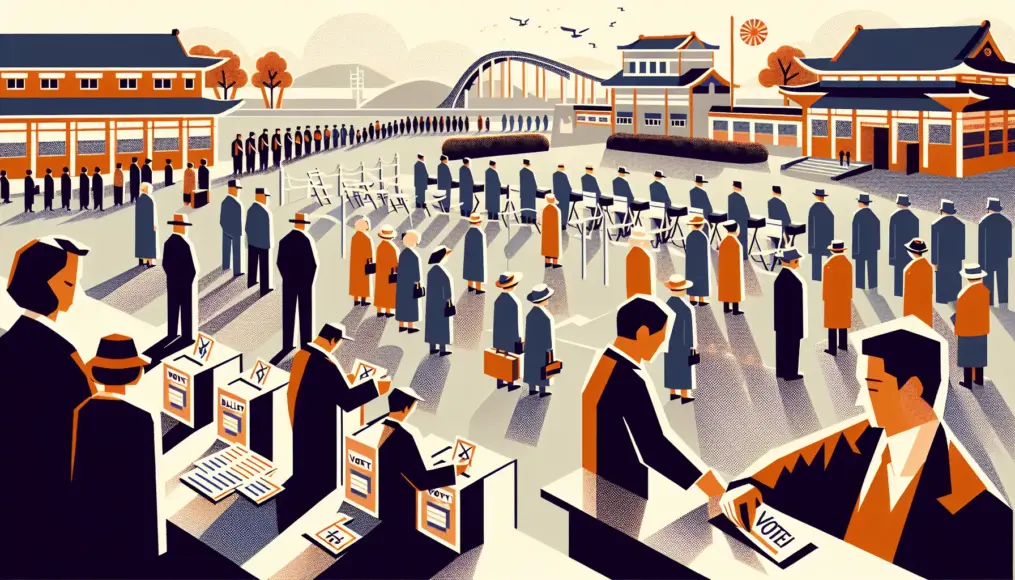Japan’s House of Representatives election system plays a crucial role in shaping the country’s political landscape. Looking back over history, we can see that the electoral framework has undergone numerous changes since the post-war political reforms. These shifts have significantly influenced how citizens engage with politics and participate in voting. Thus, exploring the House of Representatives election system is key to understanding a more vibrant democracy.
In this article, we will delve into the historical context of the election system, the unique features of the current system, and potential reforms on the horizon. Let’s examine together how the electoral process impacts society.
- The Evolution of the House of Representatives Election System and Post-War Political Reforms
- Characteristics of the Current System: Single-Member Districts and Proportional Representation
- Changes in Public Awareness and Behavior Regarding Political Participation
The Historical Background of Japan’s House of Representatives Election System
Japan’s House of Representatives election system is closely tied to the country’s political framework, reflecting the evolution of Japanese democracy. Notably, the political reforms following World War II had a profound impact on the election system, significantly altering how the voices of the people are represented in politics and highlighting the system’s importance. Understanding the history of the House of Representatives election system deepens our comprehension of the current framework and its challenges.
In this section, we will explore the changes to the election system brought about by post-war political reforms and the subsequent evolution of the election process. Reflecting on this history provides an opportunity to consider the future of the election system.
Post-War Political Reforms
In post-war Japan, political reforms aimed at establishing democracy were actively pursued. The new constitution, enacted in 1947, proclaimed popular sovereignty and guaranteed fundamental human rights, making a significant impact on the election system. During this period, House of Representatives elections were recognized as a crucial means for selecting representatives of the people, leading to an expansion of voting rights.
As a result, the election system evolved into a combination of single-member districts and proportional representation, enabling more citizens to engage in the political process. These reforms marked a pivotal moment in the political history of post-war Japan.
- Expansion of voting rights following the 1947 constitution
- Promotion of political participation through the introduction of single-member districts and proportional representation
- The impact of post-war political reforms on the election system
Evolution of the Election System
Over the years, the House of Representatives election system has continued to evolve. In the 1980s, calls for a review of the election system intensified, culminating in a new system being introduced in 1994. This change aimed to respect political diversity and achieve fairer elections.
The evolution of the election system also influenced public political awareness and voting behavior. The new system led to a tendency for results to skew toward certain political parties, altering public expectations and evaluations of election outcomes. By understanding this backdrop, we can better grasp the challenges facing the current election system and the necessity for future reforms.
If you find this topic interesting, we recommend checking out the article “What is Japan’s Electoral System? Exploring its History and Contemporary Challenges.” This piece delves into the historical context of Japan’s electoral system and examines the contemporary issues it faces, providing insights into how the evolution of the election system has influenced public political consciousness.
- Trends in the review of the election system from the 1980s to 1994
- Respect for political diversity under the new system
- Changes in public voting behavior and awareness
Understanding Japan’s Current House of Representatives Election System
Japan’s current election system for the House of Representatives operates by combining two key components: single-member districts and proportional representation. This structure aims to more accurately reflect the diverse opinions of the citizens during elections, creating an environment where various political parties and candidates can compete. Understanding this election system is vital for citizens as they consider how to voice their opinions in the political landscape.
In this section, we will take a closer look at the fundamental components of the current House of Representatives election system and its characteristics. Let’s explore how representatives are elected under this system and its broader implications.
Single-Member Districts and Proportional Representation
In the House of Representatives elections, Japan is divided into single-member districts. Each district elects one candidate, which helps clarify who wins and simplifies the election outcomes. However, this system has been criticized for favoring certain parties, making it more challenging to represent a wide range of opinions.
On the other hand, proportional representation is designed to reflect the support for political parties. The country is divided into several blocks, and seats are allocated based on the number of votes received in each block. This system allows minority opinions to be represented in the legislature, fostering a more diverse political landscape.
- Single-member districts clearly designate winning candidates
- Proportional representation reflects support for political parties
- The combination of both systems promotes diversity while ensuring clear election results
Features of the Election System
Japan’s current House of Representatives election system has several notable features. First, the right to vote is granted to all Japanese citizens aged 20 and over, promoting broad participation among the populace. Additionally, elections are held simultaneously across the country, and results are determined relatively quickly. This allows citizens to stay informed about political developments in a timely manner.
Moreover, the election system requires candidates to be officially endorsed and political parties to be registered, establishing rules that ensure transparency. However, issues such as campaign financing and potential bias towards specific parties have been raised, highlighting the need for future reforms in the system.
For those interested in deepening their understanding of the House of Representatives election system, there are other intriguing articles available. For example, you can check out the piece on the evolution and impact of candidacy age, which discusses the historical changes in eligibility age and how they have influenced the current system. This exploration of the social significance of the election system is definitely worth a read.
- Voting rights are granted to all Japanese citizens aged 20 and over
- Elections are held simultaneously nationwide, with results determined quickly
- Transparency is ensured through candidate endorsement and party registration
The Impact of Election Systems on Society
The House of Representatives election system is more than just a political framework; it profoundly influences the lives of citizens and the fabric of society. Understanding how the electoral system affects voting behavior and political participation is essential for the maturation of democracy. When a robust electoral system is in place, citizens gain a means to express their opinions in politics, taking a step toward building a better society.
In this section, we’ll delve into how the election system influences voter behavior and the role it plays in fostering habits of political participation.
Voter Behavior
Election systems have a direct impact on how citizens cast their votes. For instance, when the system is fair and transparent, citizens are more likely to trust the electoral process and participate actively in elections. Conversely, dissatisfaction with the system can lead to decreased voter turnout, ultimately undermining the health of democracy.
Additionally, the method of candidate selection under single-member districts can create support for specific parties or candidates. This can limit political choices for citizens and, in turn, affect their voting behavior.
- Fair and transparent systems enhance public trust.
- Dissatisfaction with the system influences voter turnout.
- Single-member districts may lead to biased support for certain parties.
Cultivating Political Participation
The election system also plays a crucial role in nurturing the habit of political participation among citizens. Regular elections provide opportunities for individuals to express their opinions, sparking an interest in politics. This kind of engagement can be passed down to future generations, laying the groundwork for a society where more people are involved in political processes.
Moreover, if the electoral system respects diverse opinions, citizens are more likely to understand and engage with differing perspectives. This encourages political dialogue, further deepening democracy.
When reflecting on how election systems influence voter behavior and political participation, there are many intriguing angles to consider. For instance, understanding the significant role of unified local elections in promoting civic engagement is essential. For more insights, be sure to check out the article “Exploring the Functions and Impact of Unified Local Elections.” It provides a detailed look at the background and historical developments of election systems, enhancing your understanding.
- Regular elections promote political participation.
- They provide opportunities to increase interest in politics.
- Respect for diverse opinions encourages political dialogue.
The Future of Electoral Reform in Japan
Japan’s House of Representatives election system has a long history, but it is now facing calls for reform to adapt to the changing times. The current system presents challenges, such as biased election outcomes and decreasing political participation among citizens. Addressing these issues through reform is essential. A revised electoral system could not only restore trust in politics but also create more opportunities for citizens to express their opinions.
In this section, we will explore the necessity of electoral reform and consider the direction future election systems should take. Let’s envision a new system that reflects the voices of the people.
The Need for Reform
The current House of Representatives election system reveals various challenges. Notably, the introduction of single-member districts has favored certain political parties, making it difficult for the diverse opinions of citizens to be represented. If this bias persists, it could lead to increased political dissatisfaction and ultimately lower voter turnout.
Moreover, if the electoral system does not encourage citizen participation, there is a risk of weakening democracy. Therefore, revisiting the electoral system is not just a matter of reform; it is also a crucial step in raising the political awareness of the public.
- The current system struggles to reflect the opinions of citizens
- There is a risk of decreased voter turnout
- Reform is vital for strengthening democracy
The Future of the Electoral System
The future electoral system needs to incorporate a broader range of opinions. For instance, enhancing proportional representation would make it easier for minority viewpoints to be reflected in the legislature. Additionally, introducing online voting methods and implementing measures to encourage youth participation are essential steps.
Furthermore, electoral reform should not only focus on revising the system but also align with education and awareness campaigns that promote political participation among citizens. This approach can help create a society where each individual is empowered to have their own opinions and engage in politics.
- Strengthening proportional representation to reflect diverse opinions
- Introduction of online voting and measures to encourage youth participation
- Importance of collaboration with education and awareness initiatives to promote political participation
Summary
Japan’s House of Representatives electoral system is deeply intertwined with our lives, shaped by its historical context, current framework, and societal impact. After significant political reforms following World War II, the system now combines single-member districts with proportional representation, creating a structure that aims to reflect the citizens’ voices. However, the system also faces biases and challenges that necessitate reform.
Looking ahead, the electoral system should embrace a broader array of opinions and encourage increased political participation from the public. This evolution will not only enhance democracy but also foster a society where every citizen can contribute their perspectives.
- The House of Representatives electoral system is a crucial mechanism for reflecting public opinion.
- The current system has biases and challenges, highlighting the need for reform.
- Future reforms should focus on integrating diverse viewpoints.
Our political participation is key to building a better future. We’d love to hear your thoughts and opinions, so feel free to share them in the comments!



Comment